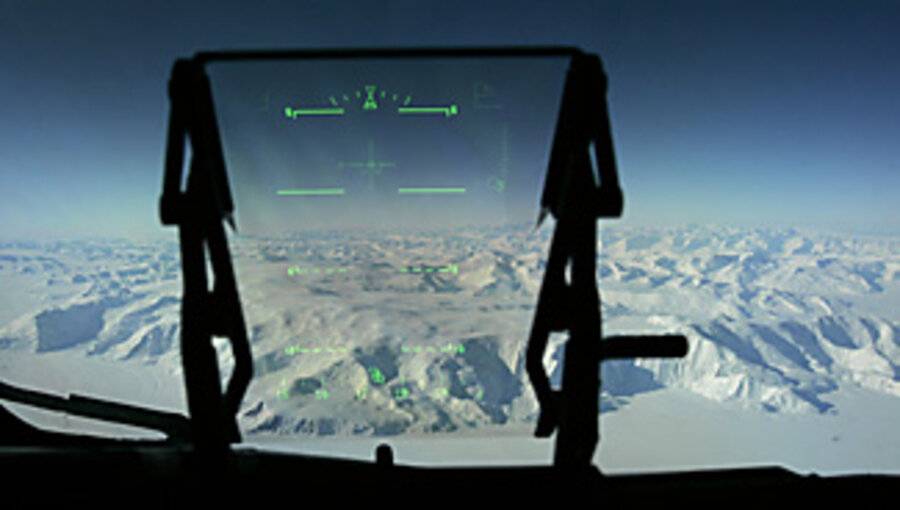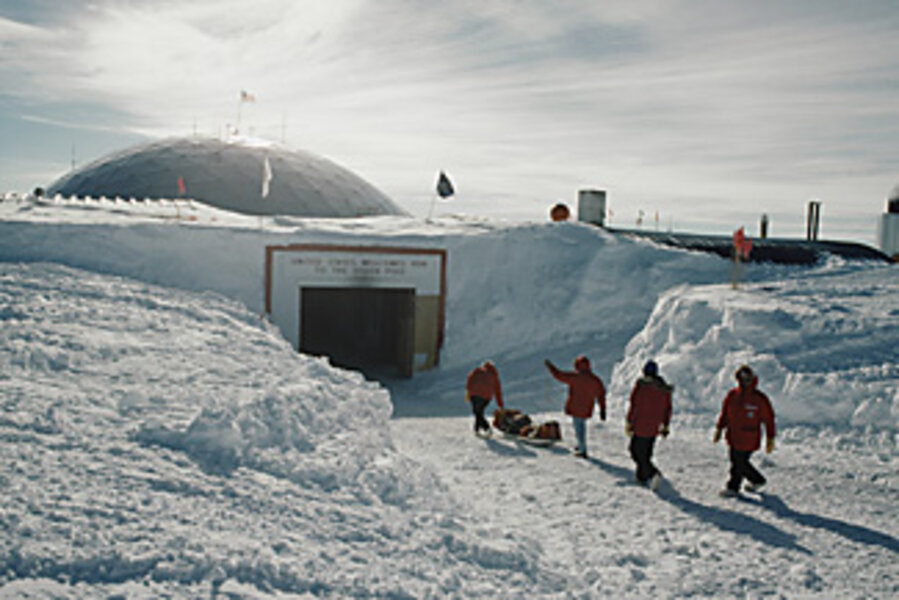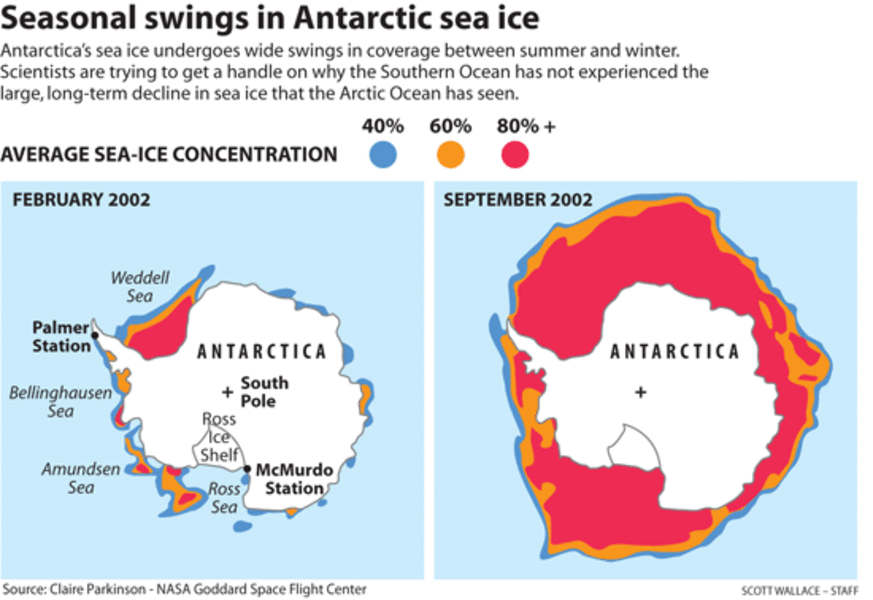As arctic ice melts, South Pole ice grows
For decades, the vast expanse of sea ice that surrounds Antarctica each winter, and all but vanishes each austral summer, has languished as the Rodney Dangerfield of Earth's cryosphere.
Antarctic sea ice has gotten little respect, especially compared with its top-of-the-world cousin, or with the enormous ice sheets on Greenland and the Antarctic continent. The sea ice is hard to reach. It has little direct effect on people. And the Southern Ocean was not a cold-war playground for US and Soviet submarines, which amassed a wealth of information on changes in Arctic sea ice before the era of long-term satellite observations.
But as a research target, southern sea ice's stock appears to be rising.
Over the past 20 years, southern sea ice has expanded, in contrast to the Arctic's decline, and researchers want to understand why. Many climate-model experiments show the Arctic responding more rapidly than Antarctica as global warming kicks in. But after looking at the latest projections from the Intergovernmental Panel on Climate Change, "Arctic sea ice is well ahead of the models, and Antarctic sea ice is well behind what the models project," says Stephen Ackley, a polar scientist at the University of Texas, San Antonio.
Moreover, recent studies have shown that in key regions off the Antarctic coast, sea ice shows a strong, coherent response to El Niño-La Niña cycles, decade-scale climate swings in the tropical Pacific whose length, strength, and timing may be affected in uncertain ways by global warming. Indeed, outside the tropics, Antarctica boasts the strongest climate response to El Niño of any region on the planet. This suggests strong climate connections and feedbacks among sea, ice, and air in the Southern Ocean that are poorly understood.
Some scientists say trends in sea ice in key spots around the continent may be bellwethers for worrisome changes that could accelerate the melt of nearby land ice, most notably the West Antarctic Ice Sheet.
The overall growth in Antarctica's sea ice over the past two decades masks significant regional declines in the Bellingshausen and Amundsen Seas – the destination for glaciers flowing from the West Antarctic Ice Sheet. Researchers say these glaciers are losing ice to the sea faster than snow is replenishing the ice. Thus, the large regional drops in sea ice could also signal the presence of "a very big threat to glacier ice" on the continent, says Xiaojun Yuan, a polar scientist at Columbia University's Lamont-Doherty Earth Observatory in Palisades, N.Y. The leading suspect: relatively warm water upwelling near the coast as a result of global warming's effect on wind patterns in the region.
To address some of these issues during the International Polar Year, which ends in March 2009, scientists are installing a network of buoys off Antarctica's coast. The buoys will track changes in sea ice and measure the factors in air and atmosphere that trigger those changes. Last August, 10 international science groups joined forces on a project dubbed SOPHOCLES, which aims to use the latest information on the Southern Ocean and Antarctica's land and sea ice to improve climate models.
'Antarctic sea ice is such a different animal'
For some commentators, the out-of-sync trends in sea ice at the two poles is evidence that warming isn't global and doesn't deserve the international angst it triggers.
Not so fast, many researchers respond. Northern and southern sea ice shouldn't necessarily act in lock-step. "Antarctic sea ice is such a different animal," says Douglas Martinson, another polar-ice specialist at Lamont-Doherty. Geographic and oceanographic differences – a virtually landlocked ocean in the north versus an open ocean in the south – encourage the buildup of thick, long-lasting, multiyear ice in the Arctic Ocean. Antarctica's sea ice, by contrast, is largely thin and seasonal. In winter, Antarctic sea ice covers an area nearly twice the size of Europe. By the end of summer, it shrinks to one-sixth of its winter extent. These wide swings make it difficult to tease out long-term trends in ice cover there.
The first big advance in monitoring Antarctic sea ice came in 1972, when the federal government launched a satellite with a microwave device to monitor ice 24/7, regardless of cloud cover.
The results were eye-opening, says Claire Parkinson, a researcher who tracks sea-ice trends at the Goddard Space Flight Center in Greenbelt, Md. During three of the first four years the instrument gathered data, an enormous open area in the ice, or polynya, appeared in the Weddell Sea – a phenomenon no one has seen there since. (A grocery-store tabloid had the obvious explanation: that scientists had discovered evidence of an undersea base run by space aliens – heat from the alleged facility had melted the ice. "It was one of our images," says a bemused Dr. Parkinson. "But it wasn't our interpretation.")
Since 1978, the satellite record shows that Antarctica's sea ice has expanded by about half a percent a year. Declines in sea ice recorded between 2000 and 2002 have significantly moderated the overall rise.
These long-term data have let scientists tease out relationships between Antarctic sea ice and natural climate variations, such as swings between El Niño and La Niña in the tropical Pacific. Recent modeling work has given scientists a sense that they are on the right track as they explore the processes affecting sea ice. Dr. Yuan, who uncovered Antarctica's coherent response to El Niño, has developed a seasonal sea-ice forecast model for key regions that scientists now use to plan expeditions.
The ice also plays a key ecological role in the region, some of which bears on the exchange of CO2 between the atmosphere, ocean, and ice, and on cloud formation.
Researchers have found that bacteria and algae that live in the ice trigger the production of huge amounts of dimethyl sulfide, a compound that, when exposed to oxygen, reacts to form aerosol particles around which moisture can condense as cloud droplets. In the ocean, algae and plankton produce the compound. But on the ice, researchers find concentrations some 3,000 times higher than in seawater. And where ice was once thought to keep the ocean from taking up CO2 or returning it to the atmosphere, the picture has grown more complex, Dr. Ackely says. Cold ice does seal in CO2. But slightly warm ice or ice under a little bit of snow begins to flush CO2 out of the ice and back into the air.
Antarctic ice may be melting from underneath
Given the complex role sea ice plays directly or indirectly in the biology and climate of the Southern Ocean region and beyond, its future under global-warming scenarios is of keen interest. Currently, models suggest that through the end of the century, Antarctic sea ice will begin an overall decline, although it isn't projected to be as dramatic as the Arctic's. There, some researchers predict summer sea ice will virtually vanish by 2013, 27 years earlier than previously projected.
A key measurement scientists are trying to make beginning this year involves the mass of Antarctica's sea ice. In the Arctic, ice began to melt from underneath before major shifts in its extent appeared. Thus, measurements of the sea ice's overall mass may uncover changes that aren't readily seen in satellite images.
One factor that could complicate this mass balance is snowfall. Researchers have long known that snow builds glaciers. Two years ago, a team of scientists combined snow-thickness measurements with modeling studies and found that, at least in Antarctica, snow also may build Antarctica's sea ice.
As the climate has warmed, more moisture has made its way to high latitudes. "In the Antarctic in particular, we expect more snowfall," says Achim Stoessel, a researcher at Texas A&M University in College Station, who took part in the study. Simulations showed that with increased snowfall, a sufficiently thick snow layer would push the ice underwater. The seawater in the snow-ice boundary would freeze, thickening the floe.
Some researchers suggest that this process may eventually arrest the decline of Arctic sea ice as well.







